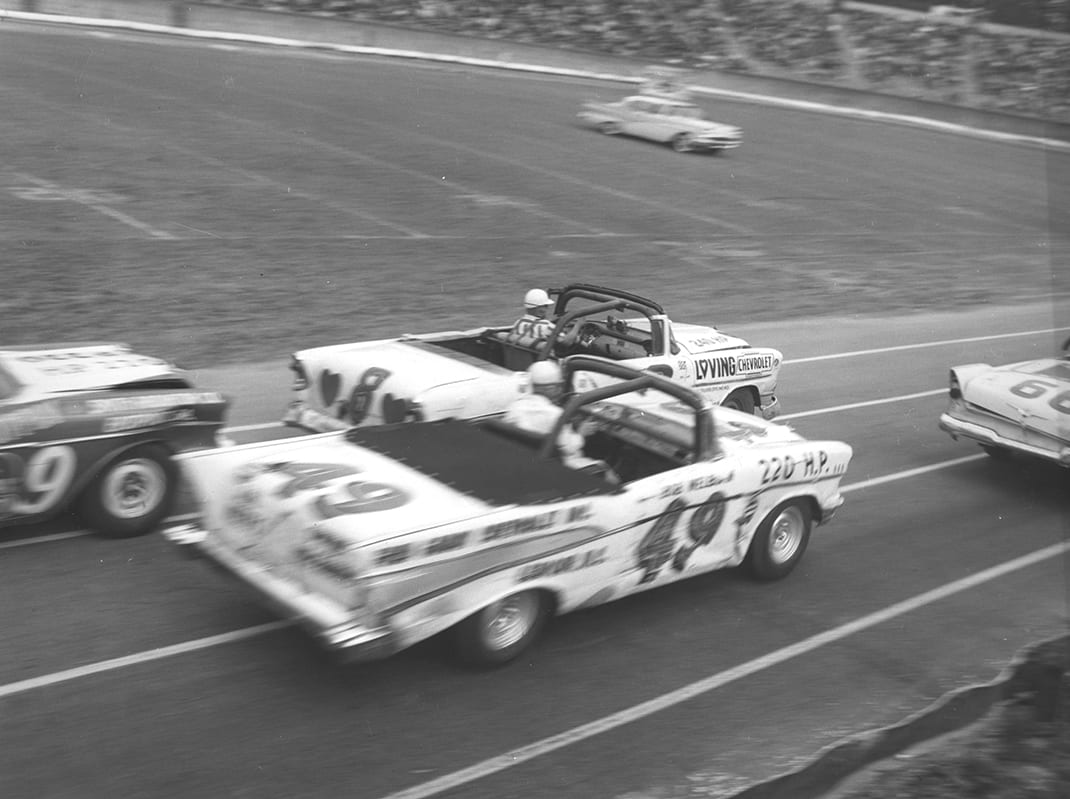In the beginning, convertibles attracted many other top Grand National stars, including Fred Lorenzen, “Fireball” Roberts and Marvin Panch.
Sadly, the open-air machines became a casualty of great scrutiny when several serious on-track crashes prompted calls for safety advancements for drivers and fans. On May 19, 1957, at Martinsville (Va.) Speedway, Billy Myers crashed his Mercury after hooking fenders with Tom Pistone and sailed through a guardrail, critically injuring an 8-year old boy.
Days after the crash, the powerful Automobile Manufacturers Ass’n ordered a withdrawal from auto racing. Teams had plenty of cars, engines and leftover parts and continued to race them on limited budgets without factory support.
Even with the division’s demise feared, the Rebel 300 on May 12, 1957, at Darlington (S.C.) Raceway was an all-convertible event with Roberts leading all but 39 of the race’s 219 laps. Later that year, Richard Petty made his first NASCAR start in a convertible at South Carolina’s Columbia Speedway, finishing sixth and winning $200.
In an effort to cut costs, France allowed zippered tops in 1958 that could be removed for Convertible events and reinstalled for Grand National races. Over time, the established stars gradually drifted away, greatly affecting attendance numbers. On March 24, 1959, NASCAR announced plans to disband the Convertible Division.
“It has become impossible to arrange an adequate convertible circuit for the 1960 season,” NASCAR Executive Manager Pat Purcell said in Fielden’s book. “The difficulty in booking was posed largely by the promoters desire to have top Grand National drivers present for all convertible races, which opened a bidding war for driver appearances. There has been a decrease in interest in the Convertible Division.”

The end had officially come after only four seasons. Convertible races were held at Darlington Raceway through 1962, but were not sanctioned by NASCAR.
“The Convertible circuit was originally from the Midwest and NASCAR just kind of took it over,” recalled Dale Inman, a 2012 NASCAR Hall of inductee as a crew chief. “Most of their drivers came and ran with NASCAR. I know in 1957, Lee Petty got a factory deal with Oldsmobile. They gave us (Petty Enterprises) three convertibles and three hard tops. It was a good series but lasted only a few short years.”
Interestingly, the inaugural Daytona 500 in 1959 at the newly opened Daytona Int’l Speedway was similar to having today’s NASCAR Sprint Cup Series and XFINITY Series run in the same race.
“The first Daytona 500 in 1959 had convertibles and hard tops in the field,” Inman said. “After the 100-mile qualifying races and what’s today the 150s, they lined up the convertibles on the inside and hard tops on the outside for the 500. The hard tops were 12 to 15 mph faster but they all started the race together. It was a popular series for a while but it just didn’t last.”
Danny “Chocolate” Myers, son of the late NASCAR Grand National driver Bobby Myers, remembers seeing the convertibles race at Bowman Gray Stadium in Winston Salem, N.C.
“What was cool about them was the fact that from the stands fans could actually see the drivers inside the cars,” Myers said. “The Convertible Division could be compared to what the Camping World Truck Series is today. We’ve always had the Cup division but at certain times in history, something else became popular for a period of time.
“In the 1950s, it was the convertibles,” Myers added. “Then in the 1960s, we had the muscle cars. Now, the trucks are popular. It’s always been that other division where you get guys that didn’t get the chance to run Cup, but ythe fans still got some extremely good racing.”
